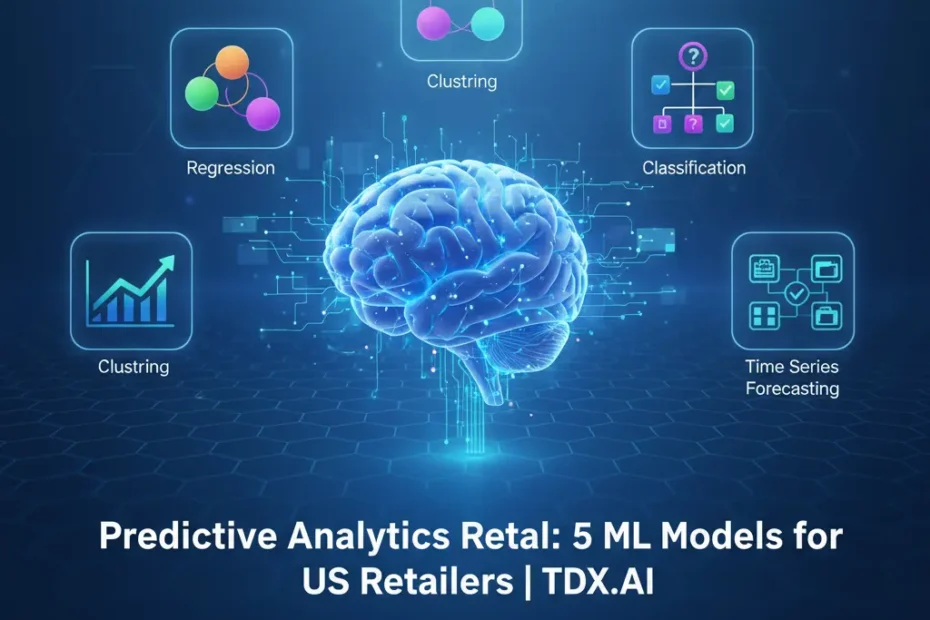Unlock growth with predictive analytics retail. Discover 5 must-use ML models for inventory, sales, and customer insights. Get expert machine learning consulting in USA from TDX.AI.
Predictive Analytics Retail: 5 Must-Use ML Models for US Retailers
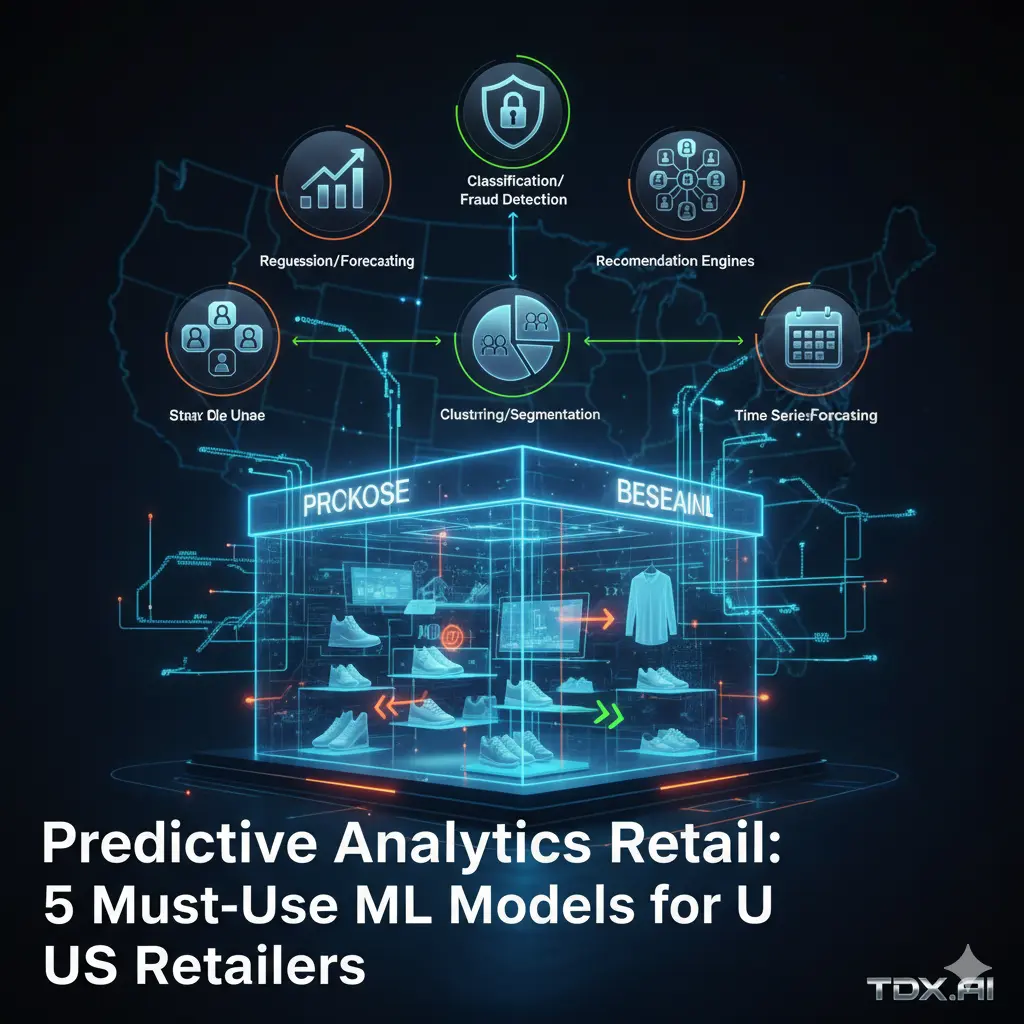
In today’s hyper-competitive landscape, predictive analytics retail isn’t just an advantage—it’s a necessity. US retailers, from booming e-commerce giants to local brick-and-mortar stores, are leveraging Machine Learning (ML) models to transform raw data into actionable insights, driving everything from precise inventory management to hyper-personalized customer experiences.
At TDX.AI, we understand the unique challenges and opportunities within the US retail sector. As a leading voice in machine learning consulting USA, we’re here to guide you through the most impactful ML models designed to put your business ahead.
Ready to move beyond guesswork? Let’s dive into the core ML models that can redefine your predictive analytics retail strategy.
How-To Guide: Understand the Power of Predictive Analytics in Retail

Before exploring specific models, it’s crucial to grasp why predictive analytics retail is a game-changer. It’s about anticipating future outcomes based on historical data. For US retailers, this means predicting demand, identifying potential stockouts, forecasting sales trends, and even understanding customer churn before it happens. This proactive approach minimizes risk, optimizes resources, and unlocks significant revenue streams.
This article specifically focuses on ML use cases for US retailers, ensuring the models discussed are directly applicable to the nuances of the American market, from seasonal shopping habits to regional demographics.
Actionable Steps: Implement a Data Foundation for Predictive Analytics Retail

Step 1: Centralize Your Data: Consolidate data from POS systems, e-commerce platforms, CRM, marketing campaigns, and even external sources (weather, economic indicators) into a unified data warehouse.
Step 2: Ensure Data Quality: Cleanse and validate your data. Inaccurate or incomplete data will lead to flawed predictions.
Step 3: Define Business Objectives: Clearly identify the specific problems you want to solve (e.g., reduce inventory waste, increase customer lifetime value). This will dictate which ML model is most appropriate.
How-To Guide: Use Regression Models for Forecasting Demand and Sales
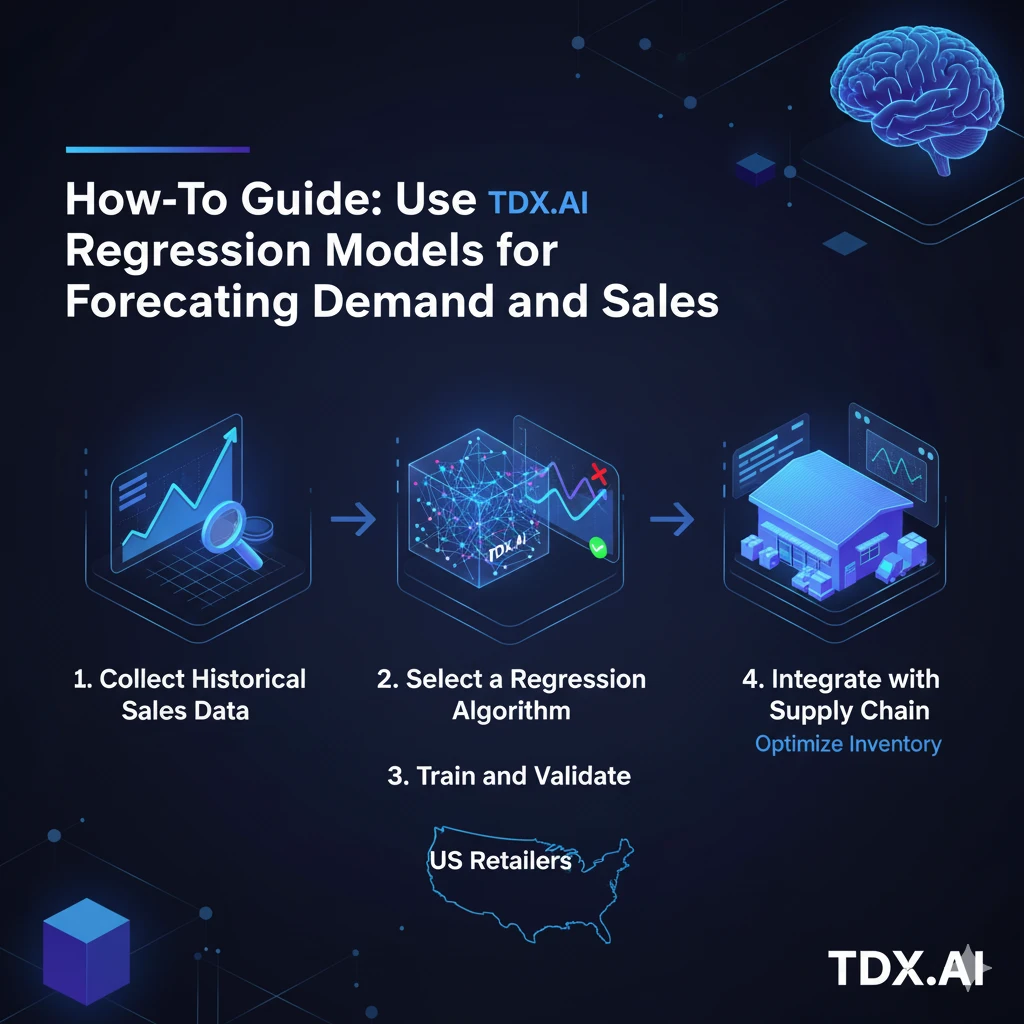
Regression models are the workhorses of predictive analytics retail when it comes to forecasting continuous values like sales volume, price fluctuations, or inventory levels. For US retailers, accurate demand forecasting is paramount to avoiding overstocking (which ties up capital) and understocking (which leads to lost sales and dissatisfied customers).
Actionable Steps: Use Regression for Optimal Inventory Management (Best Predictive Models for Inventory)
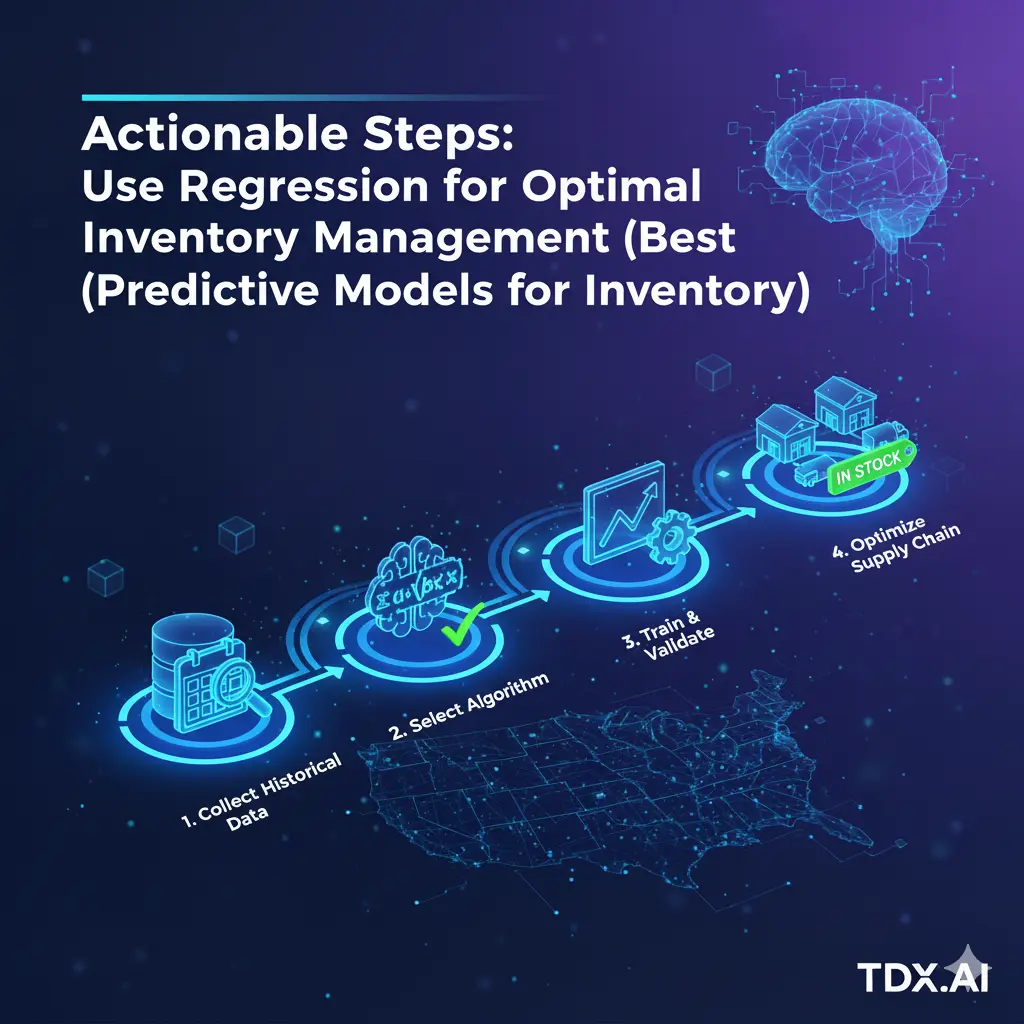
Step 1: Collect Historical Sales Data: Gather several years of sales data, including variables like promotional activities, holidays, weather, and competitor pricing.
Step 2: Select a Regression Algorithm: Options include Linear Regression (simple, for straightforward relationships), Ridge/Lasso Regression (for handling many variables), or Time Series models (ARIMA, Prophet) for time-dependent forecasts.
Step 3: Train and Validate: Train the model on historical data and rigorously test its accuracy on unseen data. Adjust parameters for seasonality, trends, and unexpected events.
Step 4: Integrate with Supply Chain: Use the forecasts to inform purchasing decisions, warehousing, and logistics, ensuring you have the right products at the right time in the right quantity. This is crucial for achieving best predictive models for inventory.
How-To Guide: Apply Classification Models to Predict Customer Churn and Fraud
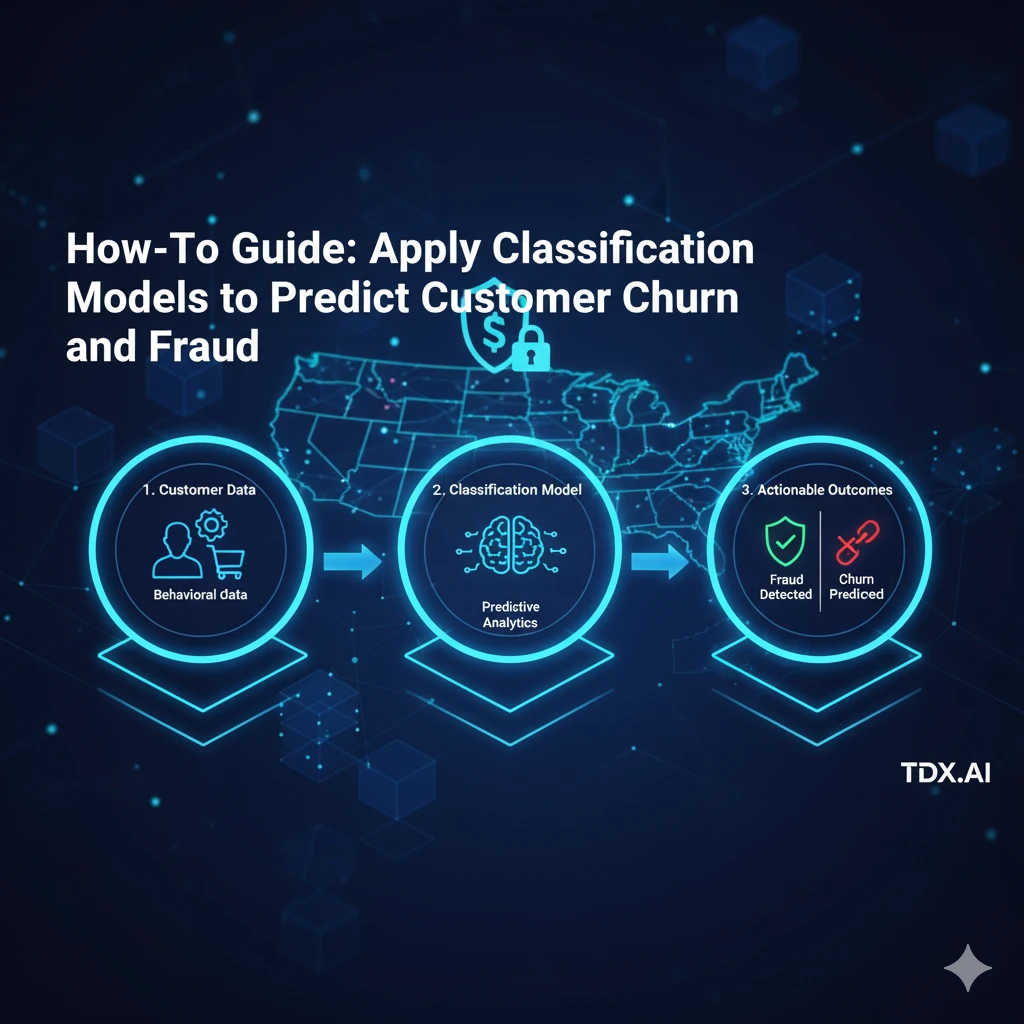
Classification models predict discrete outcomes—will a customer churn (yes/no)? Is a transaction fraudulent (true/false)? For predictive analytics retail, these models are vital for safeguarding profits and retaining valuable customers. Identifying at-risk customers allows for targeted retention strategies, while real-time fraud detection minimizes financial losses.
Actionable Steps: Predict Customer Churn (ML Use Cases for US Retailers)
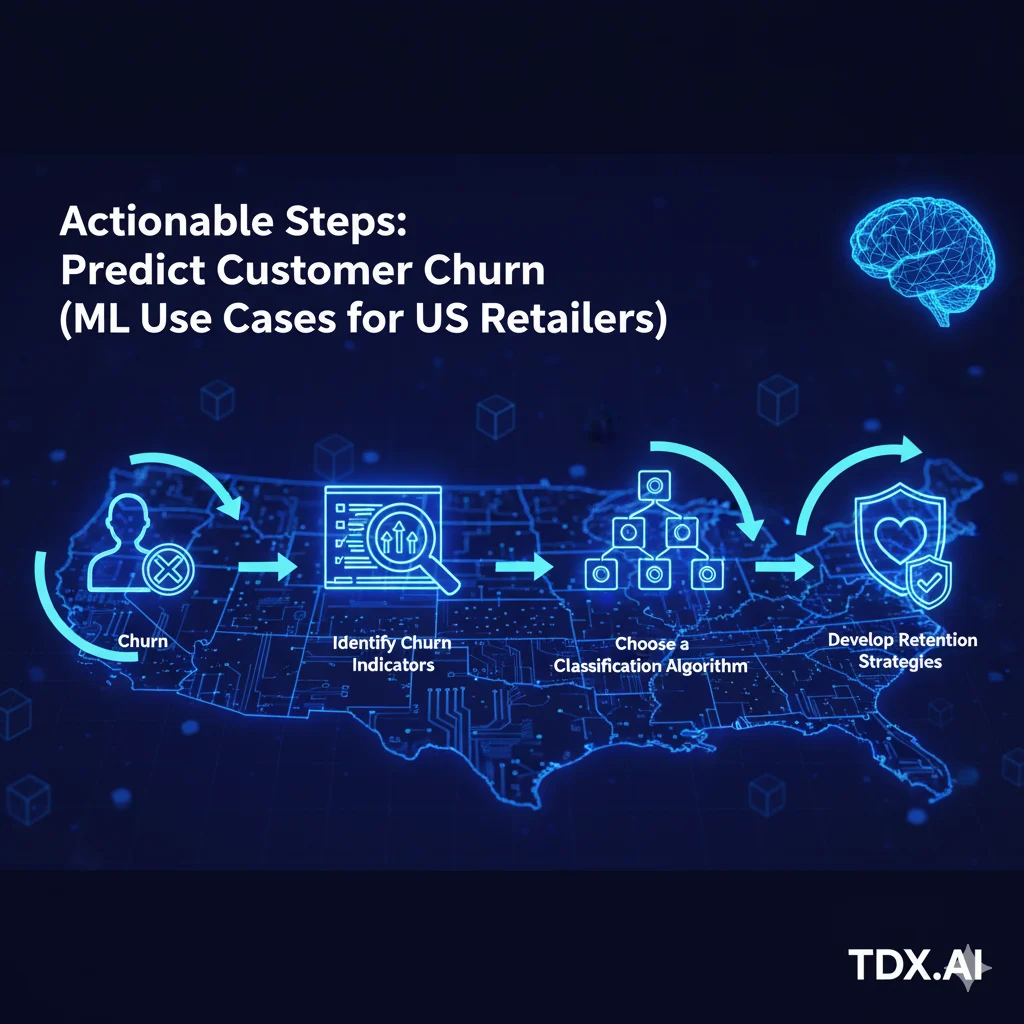
- Step 1: Identify Churn Indicators: Analyze customer behavior data, including purchase frequency, average order value, website engagement, customer service interactions, and loyalty program participation.
- Step 2: Choose a Classification Algorithm: Popular choices include Logistic Regression (for binary outcomes), Decision Trees, Random Forests, or Gradient Boosting Machines (GBM).
- Step 3: Develop Retention Strategies: Based on the model’s predictions, segment at-risk customers and deploy personalized offers, proactive outreach, or loyalty incentives. This proactive approach significantly reduces customer attrition.
How-To Guide: Leverage Clustering Models for Personalized Customer Segmentation
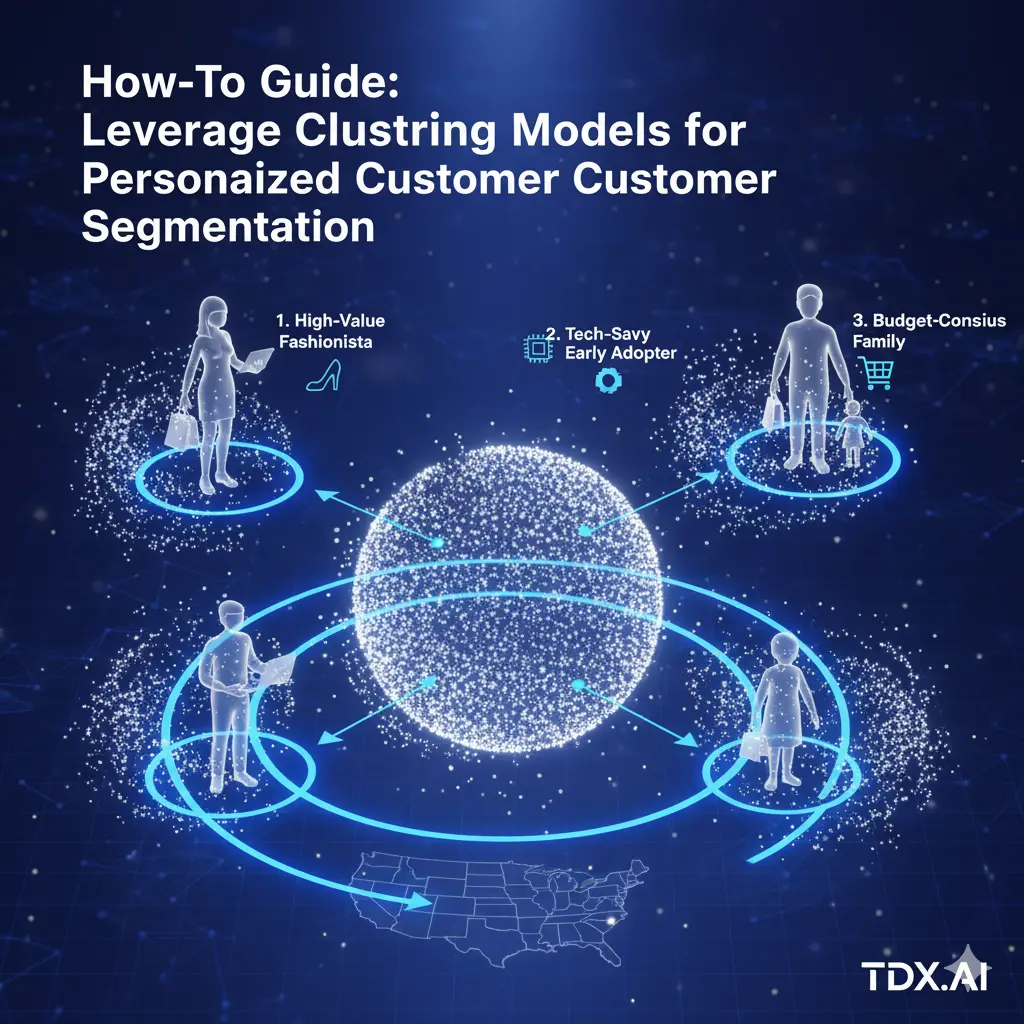
Clustering models excel at identifying natural groupings within your customer base without prior knowledge of those groups. This unsupervised learning technique is a cornerstone of advanced predictive analytics retail for hyper-personalization, allowing US retailers to tailor marketing messages, product recommendations, and even store layouts to specific customer segments.
Actionable Steps: Create Dynamic Customer Segments for Targeted Marketing

Step 1: Gather Customer Data: Collect demographics, purchase history, browsing behavior, geographic location, and response to previous campaigns.
Step 2: Select a Clustering Algorithm: K-Means is a popular and straightforward choice. Other options include Hierarchical Clustering or DBSCAN for more complex datasets.
Step 3: Interpret and Act on Segments: Analyze the characteristics of each cluster. For example, one cluster might be “High-Value, Fashion-Forward Millennials,” while another is “Budget-Conscious Suburban Families.” Use these insights to craft highly relevant marketing campaigns and product assortments.
How-To Guide: Integrate Recommendation Engines to Boost Cross-Selling

Perhaps the most visible application of predictive analytics retail to the average consumer, recommendation engines power the “Customers who bought this also bought…” and “Recommended for you” sections on e-commerce sites. These models increase average order value (AOV) and customer satisfaction by suggesting highly relevant products.
Actionable Steps: Build Effective Product Recommendation Systems
Step 1: Collect User-Item Interaction Data: This includes past purchases, browsing history, product views, ratings, and wish list additions.
Step 2: Choose a Recommendation Algorithm:
- Collaborative Filtering: Recommends items based on the preferences of similar users.
- Content-Based Filtering: Recommends items similar to those a user has liked in the past.
- Hybrid Approaches: Combine both for superior results.
Step 3: Integrate Across Touchpoints: Deploy recommendations on product pages, in shopping carts, via email marketing, and even within mobile apps to create a seamless, personalized shopping journey. This is a top-tier example of ML use cases for US retailers.
Comparison Table: ML Model Types and Benefits for US Commerce
| ML Model Type | Primary Function for Retail | Key Benefit for US Retailers | Example Use Cases |
| Regression | Predicts continuous values (e.g., sales, demand, price) | Optimized Inventory & Pricing: Reduces waste, prevents stockouts, maximizes profit margins. | Sales forecasting, demand planning, dynamic pricing strategies, best predictive models for inventory. |
| Classification | Predicts discrete outcomes (e.g., yes/no, fraud/not fraud) | Risk Mitigation & Retention: Protects revenue, reduces fraud losses, increases customer loyalty. | Customer churn prediction, fraud detection, lead qualification, identifying high-risk returns. |
| Clustering | Groups similar data points (e.g., customer segments) | Hyper-Personalization: Tailors marketing, product recommendations, and experiences to specific groups. | Customer segmentation, market basket analysis, store layout optimization, targeted promotions. |
| Recommendation Engines | Suggests relevant items to users | Increased Sales & AOV: Drives cross-selling and up-selling, enhances customer satisfaction. | Product recommendations (“You might also like”), personalized content feeds, email campaign suggestions. |
| Time Series Forecasting | Predicts future values based on historical time-stamped data | Strategic Planning: Identifies trends, seasonality, and long-term patterns for better business decisions. | Seasonal demand prediction, long-term sales planning, staffing optimization, supply chain lead time. |
Conclusion: Embracing Predictive Analytics Retail for Future Growth
The journey into predictive analytics retail is no longer optional for US retailers aiming for sustainable growth. By strategically implementing these ML models—from regression for precise forecasting to recommendation engines for hyper-personalization—businesses can unlock unprecedented efficiencies and create truly compelling customer experiences.
At TDX.AI, we specialize in providing tailored machine learning consulting USA services, helping businesses like yours navigate the complexities of data science and deploy these powerful models effectively. Don’t let your data be dormant; let it drive your future. Contact TDX.AI today to get started.
